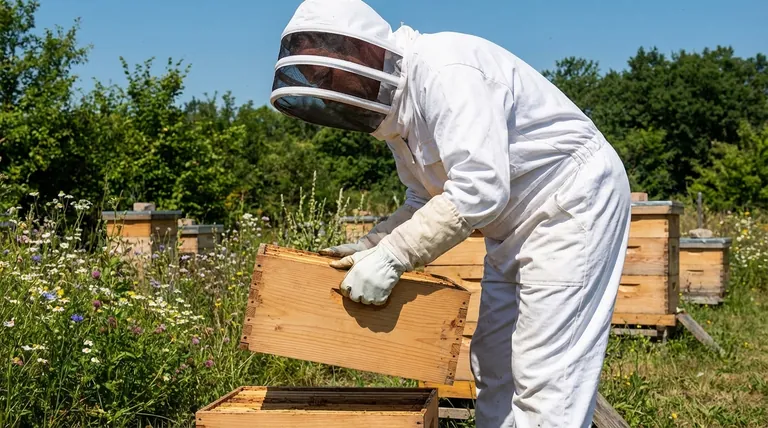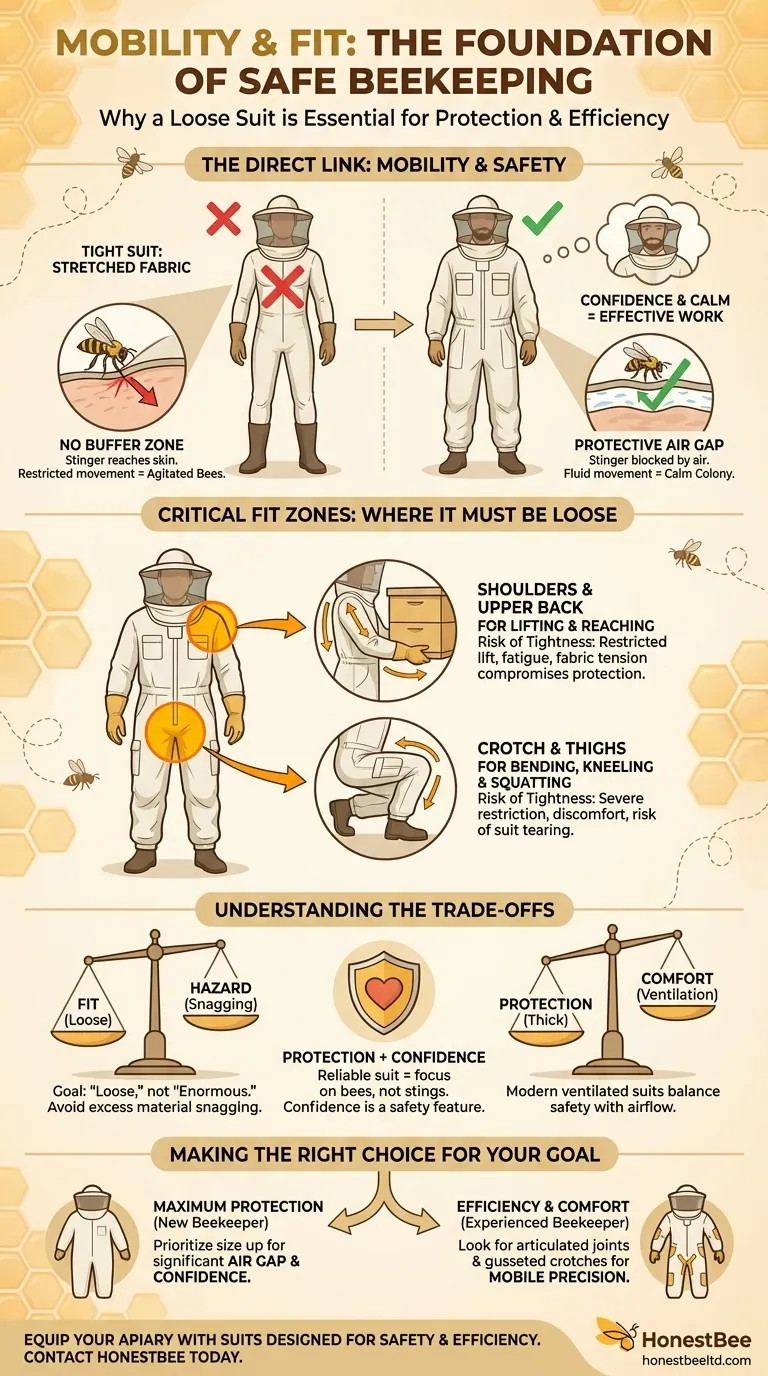In beekeeping, a suit's fit is as critical as its material. Mobility is paramount because beekeeping involves constant physical work like lifting hive boxes, bending to inspect frames, and reaching across the colony. A suit that is too tight, particularly in the crotch and shoulders, restricts these essential movements and, more importantly, can compromise your protection by stretching the fabric taut against your skin.
The ideal beekeeping suit is not just a barrier against stings; it is a uniform for effective work. A loose fit is non-negotiable, as a tight suit can paradoxically increase your risk of being stung by stretching the fabric and impeding the calm, deliberate movements required for hive management.

The Direct Link Between Mobility and Safety
A common misconception is that a suit's only job is to be a thick barrier. In reality, how the suit moves with you is a primary component of its protective function.
The Physics of a Bee Sting
A bee's stinger has a finite length. When a suit is tight against your body, it stretches the fabric, reducing its effective thickness and making it far easier for a stinger to penetrate through to your skin.
A loose-fitting suit creates a crucial "buffer zone" of air between the fabric and your body. Even if a bee manages to sting the suit, its stinger is often too short to reach you through the material and the air gap.
Calm Movements Prevent Agitation
Bees are highly sensitive to sharp, jerky motions, which they can interpret as a threat. A suit that restricts your mobility in the shoulders or legs forces you into awkward, clumsy movements.
This can lead you to bump equipment or jostle hive frames, agitating the colony and increasing defensive behavior. A suit that allows for smooth, fluid motion helps you work deliberately and keep the bees calm.
The Demands of Apiary Work
Beekeeping is a physical job. You will be squatting to observe a hive entrance, bending at the waist for extended periods, and lifting boxes (supers) that can weigh over 50 pounds. A restrictive suit makes every one of these tasks more difficult and fatiguing.
Critical Fit Zones: Where a Suit Must Be Loose
While the entire suit should be loose, two areas are absolutely critical for both mobility and protection. An improper fit here will render the suit ineffective and uncomfortable.
The Shoulders and Upper Back
This area is essential for lifting and reaching. If the suit is tight across the shoulders, you will feel significant resistance when lifting a hive box or reaching for a tool. This strain can lead to poor lifting form and fatigue.
The Crotch and Thighs
A tight crotch is the most common fit complaint. It severely restricts your ability to bend, kneel, or squat. A suit with a low or tight crotch will pull uncomfortably and may even rip under the strain of normal beekeeping tasks.
Understanding the Trade-offs
Choosing the perfect suit involves balancing competing factors. Understanding them allows you to make an informed decision.
Fit vs. Hazard
While a loose fit is essential, a suit that is excessively baggy can become a liability. Excess material can snag on hive corners, tree branches, or other equipment, creating a tripping or tearing hazard. The goal is "loose," not "enormous."
Protection vs. Confidence
For a novice beekeeper, the psychological comfort a suit provides is a major benefit. A reliable, well-fitting suit allows you to relax and focus on the bees, rather than worrying about stings. This confidence is a safety feature in itself, as a calm beekeeper is a better beekeeper.
Material vs. Climate
Thicker materials like cotton or canvas offer excellent protection but can be extremely hot in warm climates. Modern ventilated suits use layered mesh to provide a protective air gap while allowing for maximum airflow, balancing safety with comfort.
Making the Right Choice for Your Goal
Select your suit based on your primary objective and experience level.
- If your primary focus is maximum protection (new beekeeper): Prioritize a suit that is clearly one size larger than your normal clothing to guarantee a significant air gap and boost your working confidence.
- If your primary focus is efficiency and comfort (experienced beekeeper): Look for professionally designed suits with gusseted crotches and articulated joints that provide enhanced mobility without excessive material.
Ultimately, the right beekeeping suit empowers you to work with calm, confident precision, turning a simple protective garment into an essential tool for hive management.
Summary Table:
| Critical Fit Zone | Why It Must Be Loose | Risk of Being Tight |
|---|---|---|
| Shoulders & Upper Back | Allows for lifting heavy hive boxes and reaching. | Restricts movement, causes fatigue, and compromises fabric protection. |
| Crotch & Thighs | Enables bending, kneeling, and squatting comfortably. | Severely restricts movement, causes discomfort, and risks tearing the suit. |
| Overall Fit | Creates a protective air gap to prevent stings from penetrating. | Stretches fabric taut against skin, making stings more likely to reach you. |
Equip your commercial apiary or distribution business with suits designed for safety and efficiency.
At HONESTBEE, we supply beekeeping equipment and protective gear built for the demands of professional beekeepers. Our suits are designed with articulated joints and gusseted crotches to provide maximum mobility without compromising protection, helping your team work confidently and productively.
Contact HONESTBEE today to discuss your wholesale needs and discover the right equipment for your operation.
Visual Guide

Related Products
- Wholesales Dadant Size Wooden Bee Hives for Beekeeping
- Yellow Plastic Bucket Pail Perch for Beekeeping
- Professional Insulated Plastic Bee Hives
- Long Langstroth Style Horizontal Top Bar Hive for Wholesale
- Professional Insulated Winter Hive Wrap for Beekeeping
People Also Ask
- What is the best place to keep bees? Find the Perfect Apiary Site for Your Hives
- What is beekeeping equipment? Essential Tools for Commercial Apiaries & Distributors
- What types of products are available for beekeeping needs? Essential Equipment for Apiaries & Distributors
- How often should the area under beehives be inspected and cleaned during the warm season? A Proactive Maintenance Guide
- What are the characteristics of oil-based paint for beehives? Durability vs. Modern Practicality



















